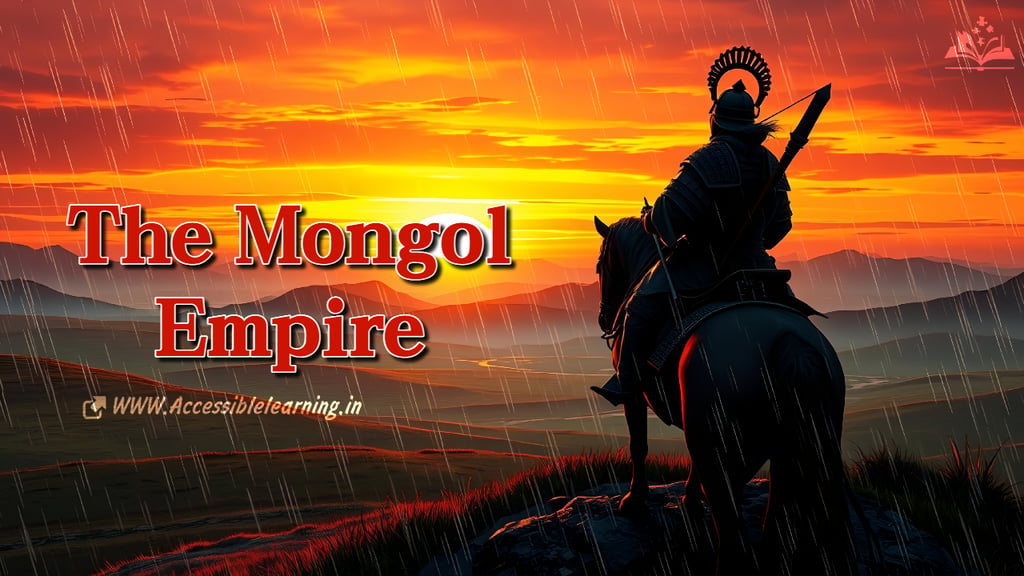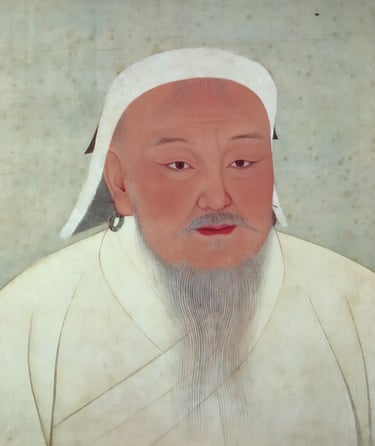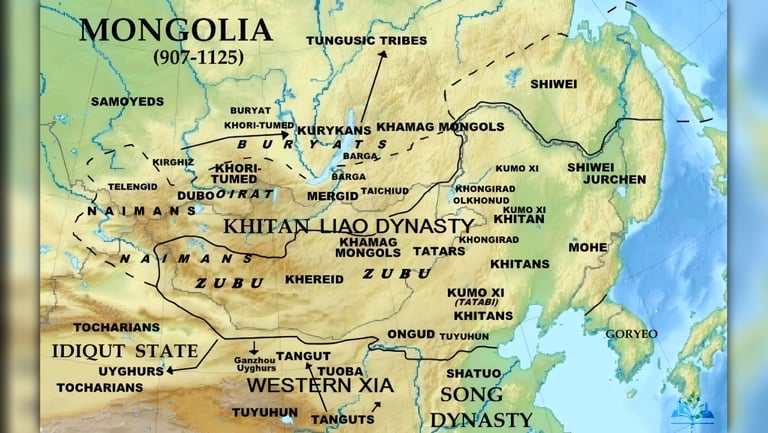
The Rise and Legacy of the Mongol Empire: How Steppe Warriors Transformed Eurasia
The Mongol Empire: From Steppe Nomads to World Power An in-depth exploration of history's largest contiguous land empire, its remarkable rise, innovative governance systems, and lasting global legacy.
EMPIRES/HISTORYCHINESE HISTORYHISTORYEDUCATION/KNOWLEDGE
Kim Shin
3/20/20258 min read


The Mongol Empire stands as one of history's most remarkable feats of conquest and administration. From humble beginnings on the windswept steppes of Central Asia, the Mongols created the largest contiguous land empire the world has ever seen, stretching from the Pacific Ocean to Eastern Europe. Their influence on world history, global trade, and cultural exchange was profound and enduring, reshaping societies across Eurasia in ways that continue to resonate today.
Origins and Rise to Power
The story of the Mongol Empire begins with Temüjin, born around 1162, into a fragmented landscape of rival nomadic tribes. Life on the Mongolian plateau was harsh and unforgiving, characterized by constant tribal warfare and the daily struggle for survival in an extreme environment.
Temüjin's early life was marked by hardship and betrayal. After his father was poisoned by rival tribesmen, his family was abandoned by their clan and forced to survive in the wilderness. These formative experiences shaped his worldview and instilled in him a remarkable resilience and strategic mind.
His rise to power was gradual but deliberate. After forming alliances with the Kereyid and Ong Khan, Temüjin demonstrated his military acumen by defeating the powerful Tartars, avenging his father's death. By 1206, he had systematically conquered or incorporated all major tribal confederations on the Mongolian steppe, including the Merkits, Naimans, and his former allies.
Through a combination of military prowess, diplomatic skill, and ruthless determination, Temüjin united the disparate Mongol tribes under his leadership. In 1206, at a grand assembly known as a kurultai, he was proclaimed "Genghis Khan" or "Universal Ruler," marking the official beginning of the Mongol Empire.
Military Innovation and Conquest
What made the Mongol military so devastatingly effective was their revolutionary approach to warfare. Their armies consisted primarily of light cavalry archers who could travel up to 100 miles per day, far outpacing their enemies. Each warrior maintained multiple horses, allowing them to switch mounts and maintain momentum during campaigns.
The Mongol composite bow deserves special mention as a technological marvel of its time. Made from layers of wood, horn, and sinew, these bows could shoot arrows with accuracy up to 300 yards—significantly farther than European longbows. Mongol warriors could fire six arrows per minute while riding at full gallop, creating devastating volleys that overwhelmed enemy formations.
The Mongol military operated with exceptional discipline and utilized sophisticated tactics that included:
Feigned retreats to lure enemies into prepared ambushes
Coordinated maneuvers using a decimal-based organizational structure
Advanced communication systems, including signal flags and smoke signals
Psychological warfare and intelligence gathering
Siege warfare techniques adapted from Chinese engineers
Mobility-focused strategy that emphasized speed and surprise
Under Genghis Khan's leadership, the Mongols embarked on campaigns that conquered the Jin dynasty in northern China, the Khwarezmian Empire in Central Asia, and territories as far west as the Caspian Sea. Following his death in 1227, his sons and grandsons continued the expansion, eventually creating an empire that encompassed approximately 24 million square kilometers at its peak.


Genghis Khan's Successors and Continued Expansion
After Genghis Khan's death in 1227, the empire was divided among his sons according to Mongol tradition. Ögedei Khan, his third son, was chosen as the Great Khan and continued the expansion. Under his rule, the Mongols conquered the remainder of Jin China and launched invasions into Eastern Europe, reaching as far as Hungary and Poland.
The death of Ögedei in 1241 prompted the Mongol forces to withdraw from Europe to participate in the election of a new Great Khan, potentially saving Western Europe from conquest. This succession crisis marked the beginning of internal tensions that would eventually fragment the empire.
Möngke Khan, a grandson of Genghis, ruled from 1251 to 1259 and oversaw campaigns that expanded Mongol control in the Middle East and Southern China. His brother Kublai Khan completed the conquest of the Southern Song dynasty in 1279, establishing the Yuan Dynasty and making himself Emperor of China.
Governance and Administration
Contrary to the popular image of the Mongols as simply destructive conquerors, they established sophisticated systems of governance that facilitated trade, cultural exchange, and relative stability across their vast domains. The empire was divided into four major khanates:
The Great Khanate (Mongolia and China)
The Chagatai Khanate (Central Asia)
The Ilkhanate (Persia and the Middle East)
The Golden Horde (Russia and Eastern Europe)
The Mongols implemented several innovative administrative practices:
Religious tolerance that allowed diverse faith communities to practice freely
A sophisticated postal relay system called the Yam that enabled rapid communication
Merit-based advancement opportunities regardless of ethnic background
Legal codes that provided stability and predictability across diverse regions
Standardized weights, measures, and currency to facilitate commerce
Census-taking and taxation systems that were remarkably efficient for their time
The Mongols were pragmatic rulers who often adapted to local customs rather than imposing their nomadic lifestyle on sedentary populations. They typically retained local administrative structures and personnel, supervising them through Mongol governors and military garrisons.
Cultural and Intellectual Exchange
The Mongol Empire facilitated unprecedented cultural and intellectual exchange across Eurasia. Kublai Khan's court in Khanbaliq (modern Beijing) became a center of learning where scholars, artists, and religious figures from across the known world gathered.
The Mongols patronized arts and sciences, resulting in significant advancements:
Astronomy flourished, with observatories built in Maragheh (Iran) and Khanbaliq
Historical writing thrived, producing works like Rashid al-Din's "Compendium of Chronicles."
Medicine benefited from the exchange of knowledge between Chinese, Persian, and Arab physicians
Mathematics advanced, particularly in the Islamic world under Mongol rule
Cartography improved dramatically, with the creation of more accurate maps of Eurasia
Artistic styles blended, creating unique aesthetic traditions in painting, ceramics, and textiles


The Pax Mongolica and Global Impact
Perhaps the most significant legacy of the Mongol Empire was the period known as the Pax Mongolica (Mongol Peace), spanning roughly from 1250 to 1350. During this time, the Silk Road trade routes operated with unprecedented security and efficiency, facilitating exchange between East and West.
This period of relative stability and interconnection had profound effects.
Technologies like paper, printing, gunpowder, and the compass spread from China to Europe
Scientific and medical knowledge flowed freely between civilizations
Artistic styles and cultural practices blended across traditional boundaries
The foundations were laid for the global exchange networks that would evolve into modern international trade systems
The Mongol Empire's facilitation of long-distance trade created new markets and consumer demands. Luxury goods from China, such as silk and porcelain, became highly sought after in Europe, while European goods found markets in the East. This exchange prefigured the global commerce that would emerge in later centuries.
Environmental Impact and Black Death
The Mongol conquests had significant environmental impacts. In some regions, particularly Iran and Iraq, the destruction of irrigation systems and depopulation led to long-term environmental degradation. Conversely, the decrease in human population in other areas allowed forests to regrow and carbon levels to drop, potentially contributing to a brief period of global cooling in the 13th century.
Perhaps the most devastating consequence of the Mongol integration of Eurasia was the spread of the Black Death. The plague bacteria, Yersinia pestis, likely originated in the Mongolian plateau and spread along trade routes established and secured by the Mongols. The pandemic killed an estimated 30–60% of Europe's population and had similarly devastating effects across Asia and North Africa.
Daily Life Under Mongol Rule
For common people living under Mongol rule, experiences varied widely depending on location and time period. In conquered territories, initial conquests could be brutal, with massive casualties and destruction. However, once Mongol rule was established, many regions experienced relative stability and prosperity.
Urban centers along trade routes flourished, with cities like Samarkand, Karakorum, and Khanbaliq becoming cosmopolitan hubs where diverse cultures intermingled. Merchants, artisans, and skilled workers often enjoyed protection and patronage from Mongol rulers eager to foster commerce and crafts.
Rural populations typically continued traditional lifestyles, though they faced new tax burdens and occasional military conscription. The Mongols generally maintained existing agricultural systems, recognizing their importance for tax revenue and food supplies.
Women in the Mongol Empire
Women in Mongol society held positions of greater authority and autonomy than in many contemporary civilizations. Mongol women traditionally managed household affairs, including finances and property, while men were often away on military campaigns. This tradition continued into the imperial period, with women from the aristocracy often wielding significant political influence.
Notable examples include:
Töregene Khatun, who served as regent of the empire from 1241 to 1246
Sorghaghtani Beki, mother of Kublai Khan, who was instrumental in securing the succession for her sons
Khutulun, the warrior princess who reportedly defeated all challengers in wrestling matches
Even as the Mongols adopted aspects of more patriarchal societies they conquered, women of the elite continued to maintain rights to property and political influence that were unusual for their time.


Decline and Legacy
By the mid-14th century, the empire began to fragment due to succession disputes, the challenges of governing such a vast territory, and natural disasters, including the Black Death pandemic, which likely spread rapidly due to the very trade networks the Mongols had established.
Internal conflicts weakened the empire, with civil wars breaking out within and between khanates. The Yuan Dynasty faced increasing resistance from the Chinese populace, culminating in the Red Turban Rebellion that helped establish the Ming Dynasty in 1368.
Though the unified empire dissolved, Mongol successor states continued to shape Eurasian history for centuries. The Yuan Dynasty in China, established by Kublai Khan, ruled until 1368. The Timurid Empire, founded by Timur (Tamerlane), who claimed Mongol heritage, dominated Central Asia in the 14th and 15th centuries. The Golden Horde influenced Russian development until its fragmentation in the 15th century.
The Mongol Empire's lasting impact can be seen in numerous areas:
Modern nations like Mongolia, Russia, China, and Iran still bear the cultural and genetic imprint of Mongol influence
Trade routes established during the Mongol era formed the basis for future global commerce
Military tactics developed by the Mongols influenced warfare for centuries
Linguistic and cultural exchanges facilitated by Mongol rule permanently altered Eurasian societies
Administrative practices and legal traditions in many regions show Mongol influences
The concept of religious tolerance as state policy was advanced by Mongol practice
Historiography and Modern Interpretations
Historical perspectives on the Mongol Empire have evolved significantly over time. Traditional European and Middle Eastern accounts often portrayed the Mongols as barbaric destroyers of civilization. Chinese histories emphasized the "foreign" nature of Mongol rule while acknowledging Kublai Khan's adoption of Chinese governance practices.
Modern scholarship has moved toward more nuanced interpretations, recognizing both the destructive aspects of Mongol conquests and their significant contributions to global history. Archaeological research, analysis of primary sources from diverse cultures, and interdisciplinary approaches have all contributed to a more balanced understanding of the Mongol Empire's place in world history.
Recent genetic studies have revealed the biological legacy of the Mongol expansion, with an estimated 0.5% of the world's male population carrying genetic markers linked to the Mongol royal family. This suggests a demographic impact that parallels the cultural, political, and economic influences of the empire.
The Mongol Empire represents one of humanity's most remarkable examples of how a small, marginalized population can rise to reshape the world order. From the harsh conditions of the Mongolian steppes emerged a force that connected distant civilizations, facilitated unprecedented cultural exchange, and created lasting networks of commerce and communication.
While popular imagination often focuses on the conquest and destruction associated with the Mongol expansion, a more complete understanding reveals their significant contributions to world history. Their administrative innovations, commitment to religious tolerance, and facilitation of cross-cultural exchange helped lay the groundwork for our modern interconnected world.
As we continue to navigate an era of global connections and cultural exchange, the story of the Mongol Empire offers valuable insights into how diverse peoples and traditions can be united under systems that promote stability, commerce, and the exchange of ideas—a legacy far more enduring than their fearsome reputation on the battlefield.
Subscribe To Our Newsletter
All © Copyright reserved by Accessible-Learning Hub
| Terms & Conditions
Knowledge is power. Learn with Us. 📚


